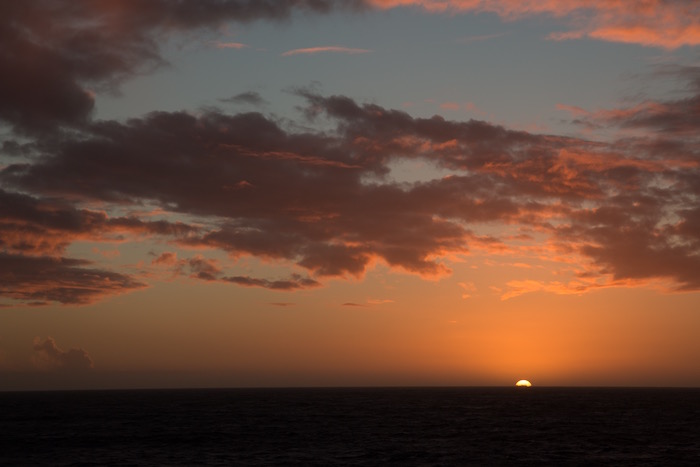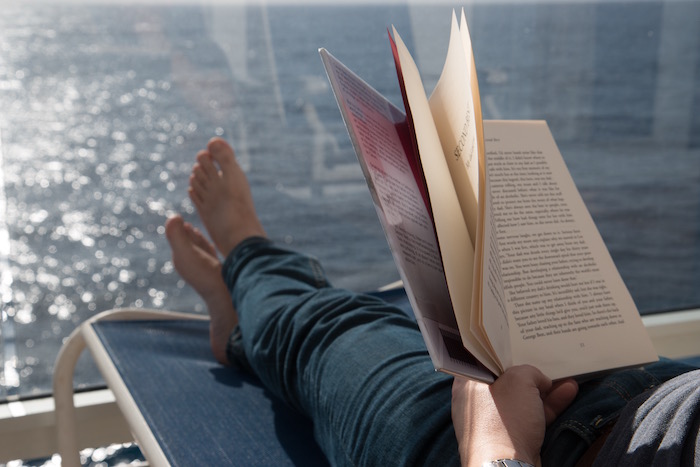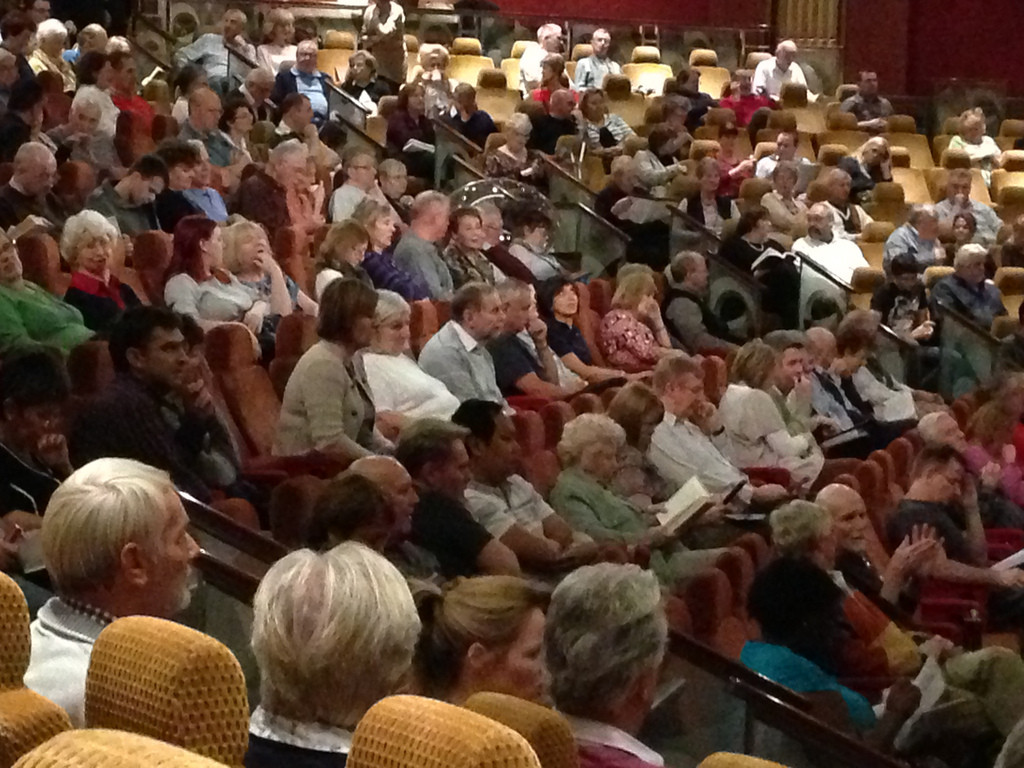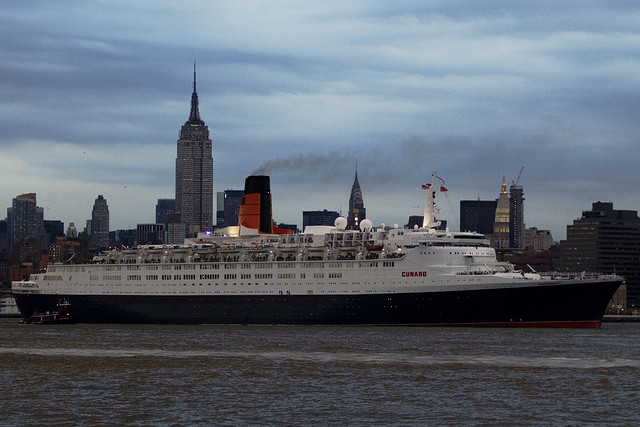Cunard World Cruise Week 3 Highlights (Aruba to Guatemala via Panama Canal)
I travelled around the world in a 12-week trip that started in Southampton UK and ended in Hong Kong. Most of it on segments of Cunard World cruise, first on Queen Victoria and then Queen Elizabeth. This 12-part series covers the journey, experiences and tips – one for each week of the journey. This post covers week three, you can read the previous week here.
Aruba to Guatemala via the Panama Canal
Day 15 (Sunday 24 January) At sea to Aruba

Relaxing on the balcony on Queen Victoria
A warm and humid day surrounded the ship as we sailed across the calm and almost glass like Caribbean Sea towards to Aruba. Clouds covered the sky until just after lunchtime, when they peeled back and the sun shone down brightly on the deck.
Despite the warmth, the sight of clouds and the many activities on offer seemed to keep most of the guests within the ship, making it quiet on deck until late afternoon. The big draw of the morning being the talk by John Laverick entitled “The Panama Canal – Its History, Construction and Operation” in the Royal Court Theatre. It was packed with crowds of people standing on the sides and back, and cluttering the stairs. It showed how for many, including myself, the upcoming transition of the canal was one of the most important parts of the voyage on this sector.
It was an interesting, if slightly dry and full of dates, talk but I left with a better understanding of the background to it being built, and what to expect on the day. However, not enough and so I went to the library in the afternoon to read up more in two of the guidebooks there. I am probably not typical though as I am fascinated by these sorts of things, and also wanted to do research to potentially use in the podcast and more detailed article for TipsForTravellers.com
The talk afterwards was by Professor Jon Wiant. He spoke about intelligence gathering techniques developed during the Cold War.
Guest Questionnaire
Those of us who had been on the previous leg were given a survey to complete (similar to the one usually done at the end of a cruise), and submit it at the Purser Desk. The questions were the same as the one for departing guests. Unlike many cruise lines I have been on the end-of-cruise survey process is a manual one still, whereas these tend to be done by the others online – with a link being sent out to guests.
Camera Club Sector 2
This was launched today, with the challenges for this sector being (1) Macro (close up photographs), (2) Landscapes and (3) Panama. There will be a repeat of the “Camera Basics” talk and one on “Landscape” picture taking. So I set about getting the challenge photographs taken, hoping to improve on the last sector when won one category and was runner up in the other two for my category. The submissions were to be judged by Beginner, Intermediate and Advanced categories again.
Day 16 (Monday 25 January) Aruba

De Palm Island Aruba
By 8am in the morning we had berthed in Oranjestad the capital of Aruba. The Aria Diva had docked just before us at the two-berth cruise terminal. It was a warm 26 degrees that built to close to 30 during the day. Big white clouds wafted over the Caribbean Blue sky during the day, and a warm but welcome breeze flowed around the island.
Aruba is just 18 miles off the coast of Venezuela and part of the Dutch Antilles. Unlike other Caribbean islands I have been to it was dry and almost desert like in parts, versus the lush intense greenery I was used to. For a time after the 1920s, it had the world’s biggest oil refinery in terms of output. The refineries closed in mid 1980s but reopened when oil prices soared in the 1990s. However, the island has since focused on encouraging land- and cruise-based tourism.
The city of Oranjestad was pretty uninspiring. Around the cruise terminal were the usual Caribbean chain shops like Diamond’s International, Effy Jewelry and Del Sol. There were many casinos and bars around the port area as well.
We took the Cunard excursion to De Palm Island, which was around a twenty-minute drive from the ship and a five-minute ferry ride. We had a great time. The part man-made island is an all-inclusive activity centre once there with beaches with white sand, water slides, snorkeling (which was excellent), zip line with open bar and buffet lunch included. For an additional charge you could go on a semi-submersible submarine, banana boat or underwater walk.
Watch the video overview I made of our time on De Palm island: https://youtu.be/8B_J4Lc9BxU
We stayed in port until just before midnight.
Passenger Mix
The overall mix of guests did not change dramatically on this leg, although the ratio of British guests fell from 76% to 66% while United States guests increased from 10% to 16%. There were 38 less passengers in total. Of the 1,811 on board 1,188 were British, 297 Americans, 84 Germans, 66 Australians and 65 Canadians. There were 25 nationalities in total.
Cunard Entertainment and Hotel Managers that I have interviewed in the past had told me that Queen Victoria and Queen Elizabeth tend to be British traveller dominated, while the Queen Mary 2 due to the Transatlantic Crossings is more multi-cultural. This seemed true on this voyage.
Although English speakers were in the vast majority, there were hosts for Japanese, German, French and Spanish speakers. Although only the German alternative was used at the daily noon address.
Burns Night and Australia Day
As today fell on Burns Night there was a themed event in the Queens Room from 7.45 to 8.30pm with speeches, poems and songs celebrating Robbie Burns. It was busy and many guests wore tartan outfits or touches of it. A large Haggis was on a table in the front, and it was also on the menus in the dining room. The evening dancing was also linked to Burns Night.
Across the voyage events linked to National Days, or significant events like this took place. For example, the next day was Australia Day and a celebration was hosted in the Golden Lion pub.
White Star Luggage Service
While there is no restriction on the amount of luggage guests could bring on board, getting it to and from the ship could have been. The driver who took us to Southampton told us how he had taken two ladies from Manchester to join this World Voyage with twelve suitcases. However, those joining and leaving the ship in ports other than local ones they faced a dilemma due to airline weight restrictions.
To assist Cunard offered, as they always do, their White Star Luggage Service run in partnership with the courier companies DHL and FedEx. For those looking to send bags back from the ship home they could meet with an on-board White Star Luggage coordinator over the next three days to get a quote and to make arrangements. It would take between three to eight working days to ship bags from Los Angeles or San Francisco home.
Prior to setting off on our voyages I had considered essential shipping bags home from our final cruise stop of Hong Kong. To give an indication of the scale of prices of the White Star Luggage service, these were the prices I was given for shipping from there to London: 1-14 kgs -297.42 GBP, 15-23 kgs -424.44 GBP and 24-34 kgs -550.20 GBP. It is, of course, possible to ship to the ship as well.
I also discovered that there was also the option to leave bags on the ship and fetch them on the day it returned to Southampton. The charge was around £50 to do this.
Day 17 (Tuesday 26 January) At sea to Cartagena Columbia

Queen Victoria Lifeboat
Theatre Box Program
The Queen Victoria has a number of boxes along each side of the three-level Royal Court Theatre. On nights when the Theatre Company performed one of their production shows, the boxes were available to hire. For a charge of $55 (plus 15% gratuity) you were greeted in a lounge area on Deck Three by uniformed Bell Boys and given champagne and finger desserts. Close to show time you were shown to your box, where more champagne and chocolates are available. The final flourish was a photograph of the theatre company. As I do not drink alcohol, the alternative offered was non-alcoholic cocktails, which we selected in advance.
Stabilisers and seasickness reduction
Since Fort Lauderdale we have been sailing in calmer waters after leaving the North Atlantic. There was almost no motion to be felt and, most of the time, it was easy to forget you were at sea. I personally like the motion and did feel cheated!
During rougher seas the Queen Victoria, like all modern liners and cruise ships have stabilisers to dramatically reduce the rolling motion that led to most seasickness. The grand liners launched in the 1930s, like Queen Mary and Queen Elizabeth, did not have this technology and so sick sickness was more likely as the ships would roll and pitch much more than they do today in similar seas.
Stabilisers were first introduced in the 1930s by the shipbuilders Denny-Brown. They are fins that retract into the hull of the ship below water and a gyroscope monitors the motion of a ship and when it detects the ship moving off a steady plane the stabilisers can be deployed and the system works to keep the ship steady and prevent rolling.
Day 18 (Wednesday 27 January) Cartagena Columbia

Isleta Island Cartenga Columbia
Opening the curtains of my cabin revealed something I had not expected, a horizon of soaring white modern condominium buildings. It felt more like sailing into modern-day Miami than the ancient and historic town I had expected Cartagena to be. The city clearly is undergoing a prosperous growth.
Cartagena is an old city founded in 1533 and became a key port shipping gold and silver back to Spain. It became an important slave trading port and today is the country’s main oil exporting port. In recent years it has also developing as a cruise port.
We sailed past the impressive skyline to dock in the busy and functional cargo harbour. Although planted in a working and unattractive dock, the Cruise Terminal was an oasis within it. As you turn off the carefully marked lane along the quay into it I was greeted with a lawn of flamingos. Inside the building is a large store full of craftwork, the expected souvenirs and emeralds (Columbia is a major producer of these). There is also a parrot aviary, bar and paid-for Wi-Fi.
I did not explore it for long as we were taking a full-day excursion out to the Rosario Archipelago islands to spend time on a private island beach. It was an hour-long speedboat ride each way and it was a paradise-like destination. The area is beautiful and the sea gorgeous with blue and green Caribbean Sea. On the island we were given fruit on arrival and a seafood lunch.

Cartenga Columbia
Zika Virus and Security Warnings
Our arrival into Columbia came with two separate warnings delivered via notes to the cabin. The first was very topical at the time, the Zika Virus that was growing in prevalence across Latin America and had been on the news, especially as a number of countries (including the UK) had issued health protection guidance for travellers visiting areas including Columbia and Panama that we were calling on.
Zika Virus is spread primarily thorough mosquitos, which bite mainly during the daytime. Symptoms of an infection occur 3-12 days after being bitten. The virus is of greatest risk to pregnant woman or those trying to become pregnant. Increasing numbers of children were being born in Latin America with the effects, which are small heads. Prevention is staying and sleeping in air-conditioned rooms, using certain types of mosquito repellent and wearing clothes that cover up as much to avoid being bitten. We had bought some repellent as a result and used it. Some younger guests avoided going on excursions, such as the goddaughter of one of the ladies on our tour.
The day before arrival we also got a letter from Captain Philpott that included the following: “I would like to advise you of the existence of a possible threat associated with extremist activity. We would remind you vigilant in all public areas, avoid demonstrations and report anything suspicious to the local authorities”.
Day 19 (Thursday 28 January) Panama Canal

Panama Canal
The danger with having a long-standing desire to do something is that when you do it will be a disappointment, or at the very least an anti-climax. Ever since I was small boy and learnt about the Panama Canal, I wanted to see and experience it. Today (finally) at age 56 I did. Despite my apprehension it would not live up to my expectations, it was a phenomenal experience that I relished every minute of. It was the highlight of my entire 82-day trip!
From just after 6.30am as the Queen Victoria gently moved through the breakwater out of the Atlantic towards to the triple Gatun Locks to moving out of the Pedro Miguel and Miraflores set of locks into the Bay of Panama and the Pacific Ocean after 4.30pm.

Panama Canal Webcam of Queen Victoria in the Panama Canal
The creation of the canal, which spans the fifty miles between the two oceans, reduced the distance ships had to sail between New York and Los Angeles by 8,000 miles. Cutting the journey by 20 days passing around the hazardous tip of South America.
It opened in 1914, but not before much loss of life and financial and political intrigue. There was a disastrous attempt by the French in the 1880s led by the man that had delivered the Suez Canal (Ferdinand de Lessops). This caused the death of 20,000 from tropical diseases and accidents and finally ended in what was the largest financial crash in 1889. The leaders were charged with fraud and mismanagement. The Americans then took on the creation of the canal and assisted an uprising against Columbia which led to Panama breaking away and becoming independent, giving the USA rights to not only build it but to have control of five miles either side of it in perpetuity. Panama finally was given control in 2000 after President Carter negotiated a deal in 1977.
During the day we were taken 85 feet up above sea level (about the height of a seven-storey building) by the Gatun locks into the huge Gatun Lake, which was the world’s largest man made lake when created, and then down the same distance in the Pedro Miguel and Miraflores locks. 15,000 ships do this every year, and more will be able to do so when new locks capable of taking even larger ships open parallel to the current ones. We saw these under construction.
Panama on the Ship
Everything was focused on the event. Commentary by an expert was piped onto the decks all day. There was a leaflet produced by the Panama Canal Authority outside our cabin in the morning. Timings of where we would be through the day were in the Daily Program. Viewing areas usually only open to crew on Deck 5 and Deck 6 Forward were open to passengers. Special Panama Canal souvenir booths were open on the Deck 5 viewing area and out on the rear Lido Pool Deck.
The photographic team was all around the ship and had three members on land and documenting every stage. The next day the entire photographic area was dedicated to their images. A special Panama Canal DVD was produced and sold for $39.95, which included a time lapse of the trip, interviews with the Captain and commentary of the trip. We all received a personalised certificate saying we had travelled through it on the Queen Victoria.
It felt very special and that we were part of something special. It was thrilling being out on the decks, added to by the thousands of people who were all over the outside balconies of the visitor centre at the Miraflores Locks not far from Panama City to watch us pass through that stretch.
I took hundreds of photographs, which took ages to get down to a more sensible number. I made a time lapse of the entire trip using my GoPro set up on our balcony.
Take a look at my photo album and also the time-lapse video I made passing through the Panama Canal: https://youtu.be/PfV0Lkx13Lk
Day 20 (Friday 29 January) At sea on way to Puerto Quetzal Guatemala

Sunset from Queen Victoria at sea
Dolphins could occasionally be seen in the middle distance around the ship leaping out of the almost surreally flat sea for most of the morning. Wind was low, temperature hung at around 28 degrees and the surface of the ocean looked like a sheet of glass. It was what I imagined sailing ships sat in when they were becalmed. Birds hovered around the ship, which the Captain joked in his midday address must be of some class and taste by choosing the stick with the Queen Victoria over other passing ships.
After the excitement and the manic nature of our Panama Canal day, the sea day was appreciated. While many were drawn to the decks to lie about, read and doze, most seemed to embrace the activities on offer with the talks (one on Dinosaurs and another on Espionage) were very full and the activities like dance classes busy.
The exhibition of photographs taken by the on-board team did a brisk trade, and we got swept up in the mood and bought a package of three photographs of the ship passing through locks as seen from land ($29.85) and ordered the DVD. They gave out raffle tickets for each Panama item purchased and I won one of the prizes. It was an official Panama Canal Calendar; the others were a 16×20 print of one of the Panama pictures taken and a Cunard Album with 16 Panama images. So I got the “worst” but still was great to win something!
Day 21 (Saturday 30 January) At sea on way to Puerto Quetzal Guatemala

Overnight the wind increased to over 35 knots and the sea shrugged off its calm coat and choppy white tufted swells caused the ship to move about. We attempted to sit out on the Grills Deck after breakfast but the gales whipped around the loungers making it unpleasant. By the afternoon it had calmed and the sun beat down with a pleasant breeze to moderate it. Many people lay about enjoying the peace and quiet.
Behind-the-Scenes Tour
On each leg of the voyage a four-hour behind-the-scenes tour was offered on one of the sea days. Restricted to just 16 guests it cost $120, and passengers had to submit interest to attend one. On this leg they ran two of these today in the afternoon. Having done them on the Queen Elizabeth and Queen Mary 2, I did not go on it this time.
These are, though, extremely interesting, informative and revealing and I would recommend them to any cruiser. Among other activities, they journey behind the Royal Court Theatre to see backstage, costumes, scenery and hear how the production shows are created and staged, the environmental facility to see and hear how the waste is recycled or processed to be released into the sea when permitted and hear what cannot be, the Medical Facility, Safety, Engineering Control Room, see the docking and anchor operations and an extensive explanation of the stores and galley and visit to the Bridge.
Taking of photographs is prohibited and one of the on-board photographers accompanied the tour to capture pictures, including a signed souvenir one in the Captain’s Chair on the bridge included in the price. A souvenir badge is also given.
Deck Party
With the weather consistently warm and inviting, a deck party was held out on the Lido Pool deck from 9.30pm with the ship’s party band called “Synergy”. They usually play a short session at lunchtime each day out there as well, with the enclosed Winter Garden the back-up venue when the weather was inclement.
The journey continues..
Read week four of the trip covering from Guatemala and San Francisco
To read the full journey:













